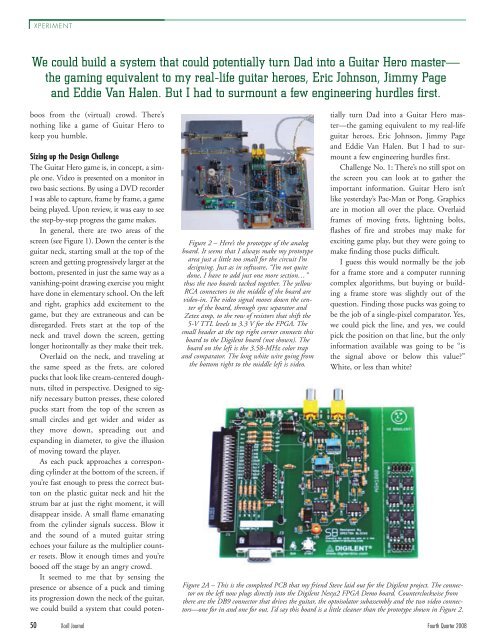Automotive Innovators Hit High Gear in - Xilinx
Automotive Innovators Hit High Gear in - Xilinx
Automotive Innovators Hit High Gear in - Xilinx
Create successful ePaper yourself
Turn your PDF publications into a flip-book with our unique Google optimized e-Paper software.
XPERIMENT<br />
We could build a system that could potentially turn Dad <strong>in</strong>to a Guitar Hero master—<br />
the gam<strong>in</strong>g equivalent to my real-life guitar heroes, Eric Johnson, Jimmy Page<br />
and Eddie Van Halen. But I had to surmount a few eng<strong>in</strong>eer<strong>in</strong>g hurdles first.<br />
boos from the (virtual) crowd. There’s<br />
noth<strong>in</strong>g like a game of Guitar Hero to<br />
keep you humble.<br />
Siz<strong>in</strong>g up the Design Challenge<br />
The Guitar Hero game is, <strong>in</strong> concept, a simple<br />
one. Video is presented on a monitor <strong>in</strong><br />
two basic sections. By us<strong>in</strong>g a DVD recorder<br />
I was able to capture, frame by frame, a game<br />
be<strong>in</strong>g played. Upon review, it was easy to see<br />
the step-by-step progress the game makes.<br />
In general, there are two areas of the<br />
screen (see Figure 1). Down the center is the<br />
guitar neck, start<strong>in</strong>g small at the top of the<br />
screen and gett<strong>in</strong>g progressively larger at the<br />
bottom, presented <strong>in</strong> just the same way as a<br />
vanish<strong>in</strong>g-po<strong>in</strong>t draw<strong>in</strong>g exercise you might<br />
have done <strong>in</strong> elementary school. On the left<br />
and right, graphics add excitement to the<br />
game, but they are extraneous and can be<br />
disregarded. Frets start at the top of the<br />
neck and travel down the screen, gett<strong>in</strong>g<br />
longer horizontally as they make their trek.<br />
Overlaid on the neck, and travel<strong>in</strong>g at<br />
the same speed as the frets, are colored<br />
pucks that look like cream-centered doughnuts,<br />
tilted <strong>in</strong> perspective. Designed to signify<br />
necessary button presses, these colored<br />
pucks start from the top of the screen as<br />
small circles and get wider and wider as<br />
they move down, spread<strong>in</strong>g out and<br />
expand<strong>in</strong>g <strong>in</strong> diameter, to give the illusion<br />
of mov<strong>in</strong>g toward the player.<br />
As each puck approaches a correspond<strong>in</strong>g<br />
cyl<strong>in</strong>der at the bottom of the screen, if<br />
you’re fast enough to press the correct button<br />
on the plastic guitar neck and hit the<br />
strum bar at just the right moment, it will<br />
disappear <strong>in</strong>side. A small flame emanat<strong>in</strong>g<br />
from the cyl<strong>in</strong>der signals success. Blow it<br />
and the sound of a muted guitar str<strong>in</strong>g<br />
echoes your failure as the multiplier counter<br />
resets. Blow it enough times and you’re<br />
booed off the stage by an angry crowd.<br />
It seemed to me that by sens<strong>in</strong>g the<br />
presence or absence of a puck and tim<strong>in</strong>g<br />
its progression down the neck of the guitar,<br />
we could build a system that could poten-<br />
Figure 2 – Here’s the prototype of the analog<br />
board. It seems that I always make my prototype<br />
area just a little too small for the circuit I’m<br />
design<strong>in</strong>g. Just as <strong>in</strong> software, “I’m not quite<br />
done, I have to add just one more section…”<br />
thus the two boards tacked together. The yellow<br />
RCA connectors <strong>in</strong> the middle of the board are<br />
video-<strong>in</strong>. The video signal moves down the center<br />
of the board, through sync separator and<br />
Zetex amp, to the row of resistors that shift the<br />
5-V TTL levels to 3.3 V for the FPGA. The<br />
small header at the top right corner connects this<br />
board to the Digilent board (not shown). The<br />
board on the left is the 3.58-MHz color trap<br />
and comparator. The long white wire go<strong>in</strong>g from<br />
the bottom right to the middle left is video.<br />
tially turn Dad <strong>in</strong>to a Guitar Hero master—the<br />
gam<strong>in</strong>g equivalent to my real-life<br />
guitar heroes, Eric Johnson, Jimmy Page<br />
and Eddie Van Halen. But I had to surmount<br />
a few eng<strong>in</strong>eer<strong>in</strong>g hurdles first.<br />
Challenge No. 1: There’s no still spot on<br />
the screen you can look at to gather the<br />
important <strong>in</strong>formation. Guitar Hero isn’t<br />
like yesterday’s Pac-Man or Pong. Graphics<br />
are <strong>in</strong> motion all over the place. Overlaid<br />
frames of mov<strong>in</strong>g frets, lightn<strong>in</strong>g bolts,<br />
flashes of fire and strobes may make for<br />
excit<strong>in</strong>g game play, but they were go<strong>in</strong>g to<br />
make f<strong>in</strong>d<strong>in</strong>g those pucks difficult.<br />
I guess this would normally be the job<br />
for a frame store and a computer runn<strong>in</strong>g<br />
complex algorithms, but buy<strong>in</strong>g or build<strong>in</strong>g<br />
a frame store was slightly out of the<br />
question. F<strong>in</strong>d<strong>in</strong>g those pucks was go<strong>in</strong>g to<br />
be the job of a s<strong>in</strong>gle-pixel comparator. Yes,<br />
we could pick the l<strong>in</strong>e, and yes, we could<br />
pick the position on that l<strong>in</strong>e, but the only<br />
<strong>in</strong>formation available was go<strong>in</strong>g to be “is<br />
the signal above or below this value?”<br />
White, or less than white?<br />
Figure 2A – This is the completed PCB that my friend Steve laid out for the Digilent project. The connector<br />
on the left now plugs directly <strong>in</strong>to the Digilent Nexys2 FPGA Demo board. Counterclockwise from<br />
there are the DB9 connector that drives the guitar, the optoisolator subassembly and the two video connectors—one<br />
for <strong>in</strong> and one for out. I’d say this board is a little cleaner than the prototype shown <strong>in</strong> Figure 2.<br />
50 Xcell Journal Fourth Quarter 2008

















